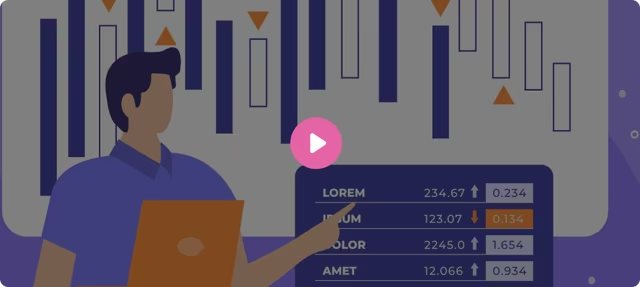 (1).png)

Technical and Fundamental Analysis in Currency Trading
Currency trading is not just about luck—it’s about informed decision-making based on solid analysis. Two primary types of analysis are used in forex trading worldwide and in Pakistan: Fundamental Analysis and Technical Analysis. Whether you're trading currency futures at PMEX or observing the USD/PKR spot rate for trends, understanding these tools is critical for success.
In this chapter by Azee Securities, a licensed broker with PMEX, we will explore how each type of analysis works and how you can apply them in the context of Pakistan’s currency market.
What is Fundamental Analysis in Currency Trading?
Fundamental analysis focuses on evaluating the economic, financial, and geopolitical factors that influence a currency's value. It attempts to determine the "true value" of a currency based on macroeconomic indicators and events.
Key Components of Fundamental Analysis:
- Interest Rates: Set by the State Bank of Pakistan (SBP), changes in the policy rate affect the strength of the PKR. Higher interest rates typically attract foreign capital, increasing demand for the local currency.
- Inflation (CPI): High inflation erodes purchasing power and weakens the currency. Traders monitor CPI reports to predict future monetary policy actions by the SBP.
- GDP Growth: A growing economy usually strengthens the national currency. Pakistan’s GDP performance indicates long-term currency strength.
- Trade Balance: A current account deficit, where imports exceed exports, puts pressure on the PKR. The more Pakistan spends on foreign goods, the more foreign currency it needs—weakening the PKR.
- Foreign Exchange Reserves: Managed by the SBP, reserves are critical in stabilizing the currency. When reserves decline, investor confidence in the PKR may drop.
- Geopolitical Stability: Political uncertainty, IMF negotiations, regional tensions, or abrupt policy changes can have immediate effects on the PKR.
- Global Events: As PKR trades mostly against USD and EUR, economic releases from the US (like NFP or Fed rate decisions) and EU also affect its direction.
How to Use Fundamental Analysis?
- Follow SBP’s monetary policy statements.
- Track economic calendars for data releases.
- Monitor news about inflation, trade, and reserves.
- Subscribe to Azee Securities' research updates for local insights.
What is Technical Analysis in Currency Trading?
Technical analysis involves evaluating price charts, patterns, and indicators to predict future price movements. It is based on the idea that historical price movements tend to repeat themselves due to market psychology and supply-demand behavior.
Technical analysis is widely used in short- to medium-term trading, especially by day traders and scalpers trading on PMEX currency futures.
Key Elements of Technical Analysis:
- Price Charts
- Line Charts: Simple price movement over time.
- Bar Charts: Open, high, low, and close values.
- Candlestick Charts: Most widely used in forex trading.
- Support and Resistance Levels
- Support: A price where buying interest is strong enough to stop a fall.
- Resistance: A price where selling interest can halt a rise.
- Trendlines and Channels: Traders draw lines to spot upward or downward trends. A consistent trend offers trading opportunities until it's broken.
- Indicators and Oscillators:
- Moving Averages (MA): Smooth out price data to identify trends.
- Relative Strength Index (RSI): Measures momentum—overbought or oversold conditions.
- MACD (Moving Average Convergence Divergence): Identifies trend reversals.
- Bollinger Bands: Measure volatility and price range.
- Volume Analysis: Though limited in forex compared to stocks, volume indicators at PMEX can show strength behind a price move.
- Chart Patterns:
- Head & Shoulders: Reversal pattern.
- Triangles: Indicate continuation or breakout.
- Double Top/Bottom: Indicate trend reversal.
Fundamental vs Technical: Which One is Better?
| Aspect | Fundamental Analysis | Technical Analysis |
|---|---|---|
| Timeframe | Long-term | Short- to medium-term |
| Focus | Economic & geopolitical factors | Price trends, patterns & volume |
| Data Type | News, macroeconomic data | Charts, indicators, historical price |
| Best For | Position Traders, Analysts | Day Traders, Scalpers, Swing Traders |
A smart trader doesn’t choose one or the other—they combine both to develop well-rounded strategies.
Applying Analysis at PMEX with Azee Securities
At PMEX, currency trading is done through futures contracts, such as USD/PKR. You can apply both types of analysis as follows:
- Use fundamental insights to predict long-term PKR trends (e.g., impact of SBP rate hike).
- Use technical analysis to enter and exit trades efficiently, especially intraday.
As a client of Azee Securities, you receive:
- Access to live trading platforms with built-in technical indicators.
- Daily technical analysis reports.
- Economic calendar updates with local relevance.
- One-on-one advisory sessions with trained analysts.
Quick Recap
- Fundamental Analysis helps assess the economic health of a country. Key factors include interest rates, GDP, inflation, and political stability.
- Technical Analysis focuses on price patterns and indicators to predict currency movements.
- Both are essential tools in forex trading—especially at PMEX where futures are traded.
- Traders in Pakistan should use a combination of both approaches for better trading outcomes.
- Azee Securities supports clients with expert research and trading tools tailored to Pakistan’s market.
Get Started with Azee Securities
Ready to start your investment journey with Azee Securities? Open a Stock Trading Account and gain access to the Pakistan Mercantile Exchange (PMEX). Let Azee Securities help you make informed decisions. Our expert advisors, advanced trading platform, and real-time market data ensure you stay ahead of the curve.
Azee Securities Private Limited
Member Pakistan Stock Exchange | PMEX | NCCPL | CDC
SECP Registered & Regulated